Axie Infinity 之后 Ronin 的潜力何在?
 JinseFinance
JinseFinance
Source: Chainalysis; Compiled by Wuzhu, Golden Finance
As in previous years, North America remains the world's largest cryptocurrency market, with an estimated on-chain value of $1.3 trillion between July 2023 and June 2024, accounting for approximately 22.5% of global activity.
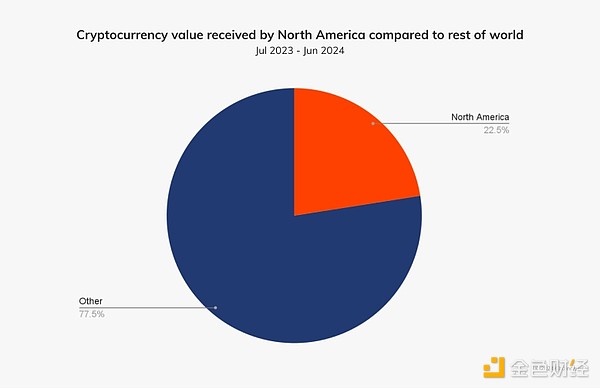
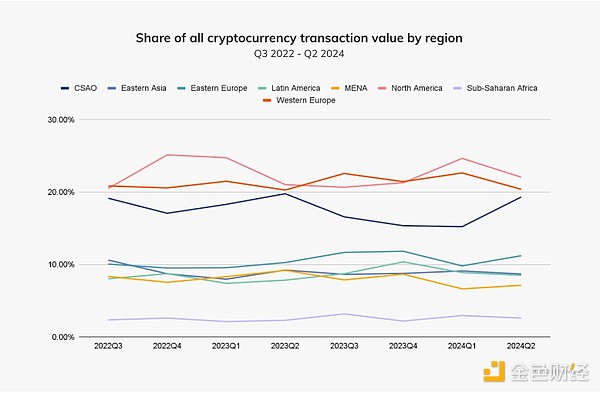
North America’s dominance in the cryptocurrency market is largely driven by institutional activity—more than any other region. About 70% of the region’s cryptocurrency activity involved transfers of more than $1 million, reflecting the growing influence of major financial players in the region’s cryptocurrency market.
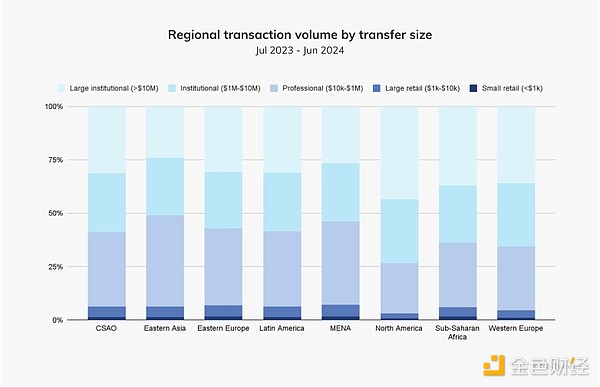
This activity is overwhelmingly driven by the United States, with 2024 proving to be a critical year for cryptocurrency adoption and industry growth in the country.
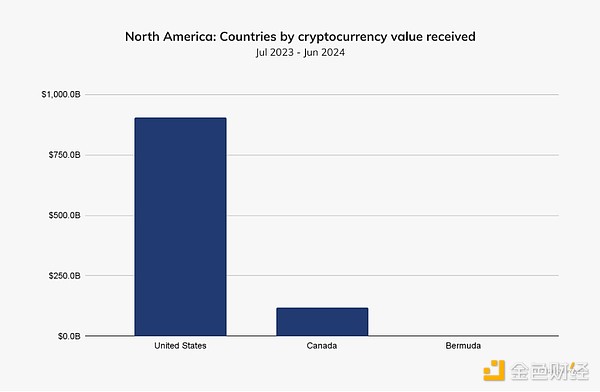
After a bear market partially spurred by the FTX crash in late 2022 and the collapse of Silicon Valley Bank in March 2023, the North American cryptocurrency industry has made a remarkable recovery. In March 2024, the price of Bitcoin (BTC) surpassed $73,000, setting a new all-time high, marking a recovery from a period of sustained volatility, ultimately strengthening the integrity and resilience of the ecosystem.
In 2024, the convergence of traditional finance (TradFi) and cryptocurrencies was consolidated, and the launch of spot Bitcoin exchange-traded products (ETPs) in the US market strengthened institutional enthusiasm. In particular, exchange-traded funds (ETFs) – the most popular and well-known type of ETPs – have attracted attention from both retail and institutional investors.
The North American cryptocurrency landscape has more substantial institutional momentum than ever before. Established financial entities such as Goldman Sachs, Fidelity and BlackRock, which have influenced U.S. and global financial markets for decades, are now taking on a prominent position in the cryptocurrency space. This marks a critical maturity point for the industry as cryptocurrencies become increasingly mainstream.
The U.S. cryptocurrency market is the largest and most influential in the world, leading the way globally.
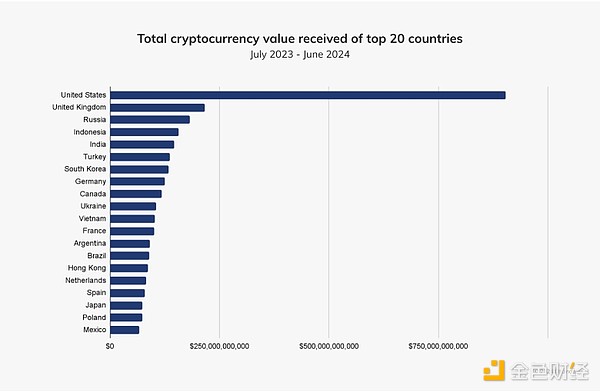
This prominence stems in large part from the country’s vast wealth, large population, deep and liquid capital markets, and thriving innovation ecosystem. The United States also benefits from political stability, a favorable investment climate, and the dollar’s current status as the international financial system’s primary reserve currency. Supported by these factors, the United States is a global leader in cryptocurrency adoption, ranking fourth in our annual Global Adoption Index.
In terms of growth, the volatility of the U.S. market is significantly higher than that of global markets. In recent quarters, the United States has shown a high sensitivity to both bull and bear markets. When cryptocurrency prices rise, the U.S. market grows more than the global market, while the opposite is true when cryptocurrency markets fall. We can see this trend below, comparing the growth rates of the U.S. and global markets to Bitcoin's returns.
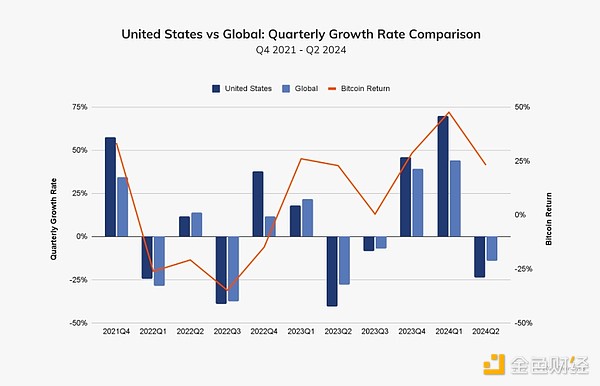
This volatility can be largely attributed to the significant levels of institutional activity within the country, a trend that has made the U.S. market a key driver of global financial trends such as cryptocurrency and TradFi.
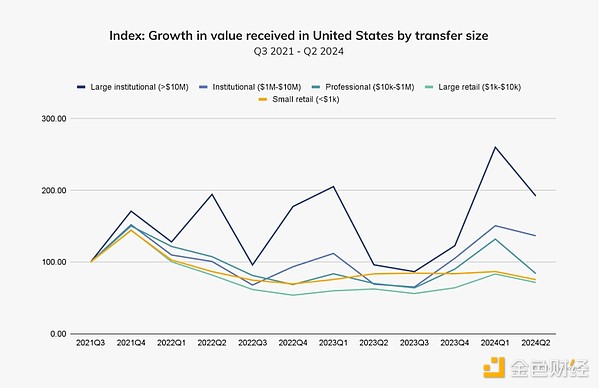
At the same time, the United States is becoming the world's leading user of centralized services in the cryptocurrency field, reflecting the increasing reliance on centralized financial (CeFi) platforms such as Coinbase and Gemini for custody and asset management.
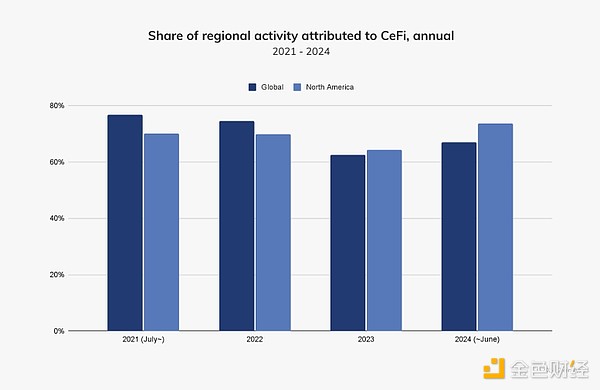
Growing demand for crypto-related financial products such as ETPs (which we’ll explore in more detail below) could drive demand for CeFi.
Institutional head of centralized exchanges and custodian Gemini stressed the importance of making digital assets accessible to everyday users through centralized platforms. “At Gemini, we’re in the abstraction business — our job is to simplify crypto-native technology so that anyone with a mobile phone can securely access digital assets,” she explained.
In addition, the entry of institutional giants such as BlackRock into the crypto space highlights the growing convergence of TradFi and crypto. To gain insight into this development, we spoke with Kevin Tang from BlackRock’s Digital Assets team. BlackRock’s foray into digital assets has been carefully planned — including BTC and ETH ETPs and tokenization — with strategic CeFi partnerships setting the stage for its success. For example, in 2022, BlackRock partnered with Coinbase to integrate Coinbase Prime functionality into the company’s proprietary investment management platform, Aladdin. This integration enables BlackRock and its clients to seamlessly manage Bitcoin and Ethereum risk alongside traditional assets. “Platform integrations are critical to building foundational functionality, ultimately paving the way for the construction of IBIT [iShares Bitcoin Trust],” Tang explained.
Centralized platforms will likely still play a key role in driving the ongoing TradFi-cryptocurrency convergence. “CeFi and centralized institutions have been critical in driving the development and provision of infrastructure that enables companies like BlackRock to operate in the [crypto] space,” Tang stressed.
As we have explored in other global crypto markets, the launch of a spot Bitcoin ETP in the U.S. in January 2024 had a transformative effect on both U.S. and global crypto markets, driving institutional interest and bringing unprecedented inflows to BTC.
Following SEC approval, the market immediately experienced a global price bull run, delivering massive positive returns just weeks after launch.
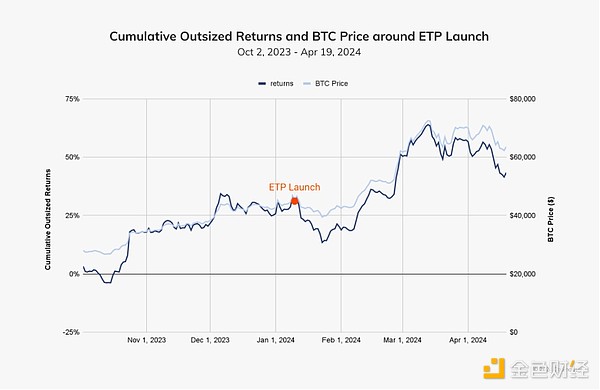
While it is impossible to completely isolate the impact of the US Bitcoin ETP launch, it is widely believed that ETPs helped bullish market sentiment and increased institutional BTC exposure. This wave of demand is attributed to the ETP's ability to meet the needs of both retail and institutional investors, providing a familiar, regulated tool to gain BTC exposure while avoiding the complexity of managing a private wallet or using crypto-native infrastructure.
The launch of the US Bitcoin ETP, and the Ethereum spot ETP launched a few months later, marked a key moment in the convergence of TradFi and cryptocurrencies, primarily because of its impact on institutional interest and broader market sentiment. The cryptocurrency market has experienced a significant rally as Bitcoin ETPs have been approved in the U.S.
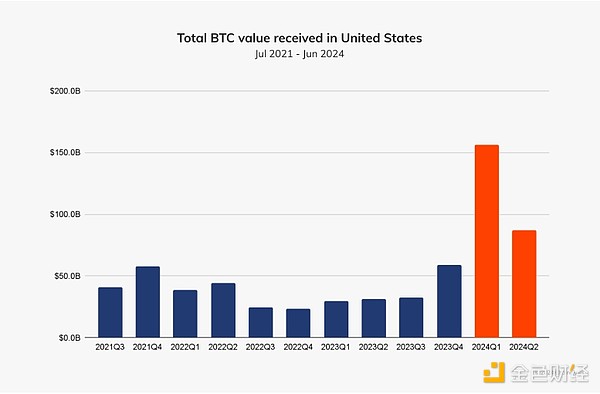
To gain more insight into the impact of this milestone, we asked Kevin Tang of BlackRock, whose iShares Bitcoin Trust (IBIT) has become the most popular BTC ETP, to discuss its implications. "The launch of the U.S. Bitcoin ETP is historic and illustrates the pent-up demand among investors for a low-cost, efficient and secure way to invest in Bitcoin." IBIT has broken multiple records, including being the fastest ETP to reach $10 billion and the record for assets under management (AUM) to reach $20 billion. “We have high expectations for asset collection via the Bitcoin ETP, and the strong client interest we have seen so far represents a win for ETF wrappers,” said Tang.
Within the first 200 days of launch, inflows into the U.S. Bitcoin ETF far exceeded even the historically most popular gold ETF, making it the most popular ETP category in history.
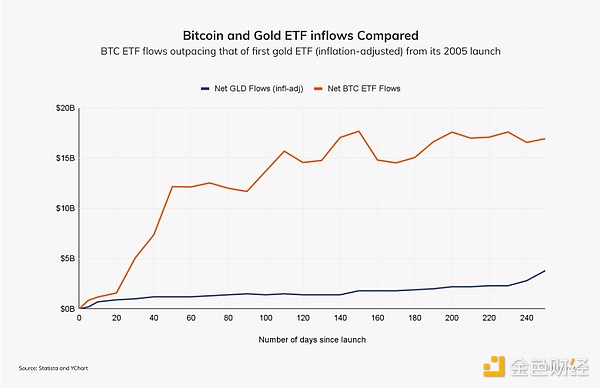
This rapid adoption confirms the strong underlying demand for regulated, institutional-grade products that provide access to BTC.
The impact of the U.S. Bitcoin ETP is not just a U.S. phenomenon, it has far-reaching implications and is also setting the stage for a broader wave of adoption internationally. Tang noted that the product has attracted investments from Asia, Europe, and Latin America. “The global impact of these ETPs is undeniable.” Tang further stressed that Bitcoin is increasingly viewed as a global currency alternative and a unique diversification tool for portfolios, especially as a potential hedge against inflation or geopolitical instability — a point echoed in BlackRock’s recent white paper on the unique value proposition Bitcoin offers investors. The growing acceptance of BTC and ETH as assets worthy of serious investment paves the way for broader institutional adoption. Tang noted that many investors are now having deeper conversations about the role of BTC and other crypto assets in their portfolios. “They are asking how Bitcoin fits into their portfolios alongside other traditional investments,” he said, noting that the launch of ETPs has opened the door to wider access to cryptocurrencies. “ETPs have shifted the conversation to the investment merits and value proposition of BTC and ETH, rather than just the logistical challenges of how to access them,” Tang explained.
For many institutions, Bitcoin ETPs are the first step toward deeper engagement in the cryptocurrency market. This exposure could ultimately lead to broader investments in blockchain technology and decentralized finance (DeFi), far beyond exposure to BTC and ETH prices.“Right now, we are focused on BTC and ETH because we see clarity in demand and regulation,” he explained. “We remain committed to meeting the needs of our clients as the market evolves.”
Through their ongoing efforts to educate investors and build trust in the space, traditional financial institutions (FIs) such as BlackRock are playing an important role in reshaping the way institutions approach cryptocurrencies, laying the foundation for broader adoption in the future. As Tang put it, “We strongly believe in the potential of blockchain technology, and tokenization in particular, to disrupt traditional finance.”
Despite record activity, the U.S. market has also faced some challenges over the past year, including a notable departure of stablecoin activity from the U.S. regulatory platform. This trend may reflect the hurdles presented by the slow progress of regulation of stablecoins and digital assets more broadly.
As of 2023, the share of stablecoin trading on U.S.-regulated exchanges has been steadily increasing, consistent with increased global stablecoin adoption. However, by 2024, this trend begins to reverse, as shown below.
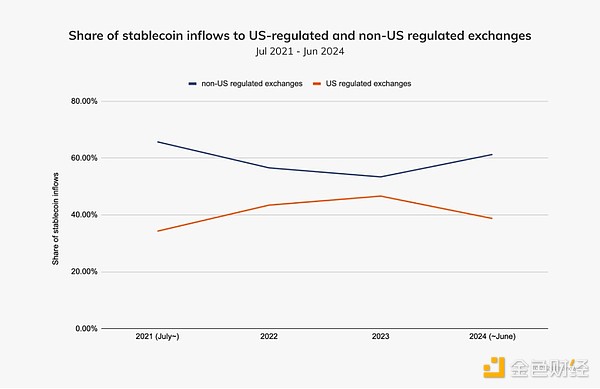
Given the surge in stablecoin adoption in emerging and global markets, this shift may reflect a relative, rather than absolute, decline in stablecoin usage within the U.S. market. More and more stablecoin trading now occurs on exchanges that are not regulated in the U.S., suggesting that global stablecoin adoption is outpacing growth in the U.S.Below, we can see U.S.-regulated and non-U.S.-regulated stablecoins. Regulated exchanges are growing, but non-US exchange markets are seeing even faster growth in stablecoin activity.
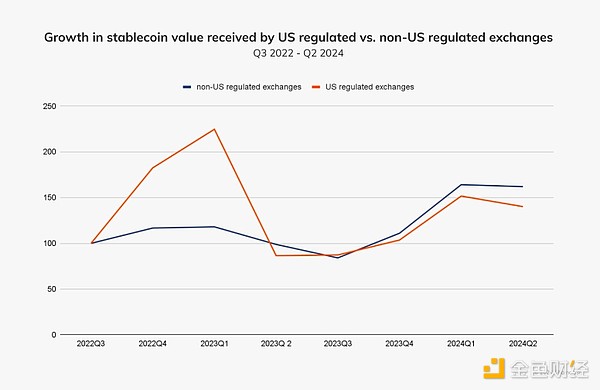
As mentioned above, this shift does not necessarily indicate a sharp decline in US market participation, but rather a rapidly expanding role for stablecoins in emerging and non-US markets.
To further understand the evolving stablecoin market, we spoke to Circle, the issuer of USDC, a stablecoin pegged to the US dollar. Circle highlighted the growing global demand for USD-backed assets, particularly among those outside the traditional banking system who have limited access to stablecoins.
“One way to think about the near-term opportunity for USDC is to look at the global demand for fiat U.S. dollar cash,” a Circle spokesperson explained. “The Federal Reserve estimates that nearly $1 trillion in U.S. banknotes (45% of all banknotes in circulation) are held outside the United States, with two-thirds of $100 bills circulating abroad. This demand exists despite the difficulties people outside the United States face when trying to access dollars through their local banking systems.”
The growth in stablecoin usage outside the United States reflects a broader trend where international markets facing currency volatility are turning to dollar-denominated stablecoins to preserve value and facilitate faster, cheaper transactions. Stablecoins such as USDC and USDT (Tether) offer a compelling solution to gain access to the stability of the U.S. dollar without using traditional banking channels, which are often more difficult to access outside the United States.
Nevertheless, regulatory uncertainty in the United States is threatening the country’s leadership in the stablecoin space. Circle noted that the lack of regulatory clarity in the United States has allowed other financial centers such as the European Union (EU), the United Arab Emirates (UAE), Singapore, and Hong Kong to attract stablecoin projects with more favorable regulatory frameworks. “Europe has succeeded in doing what the United States has not yet done with the MiCA framework: providing legal and regulatory clarity for the entire digital asset market,” the spokesperson noted. The Markets in Crypto-Assets Regulation (MiCA), which comes into effect in June 2024, lays the regulatory foundation for stablecoins in the European Union.
Regulatory clarity outside the United States is driving the growth of stablecoins around the world, leaving the United States at risk of falling behind. “The lack of a regulatory framework for dollar-denominated stablecoins in the U.S. poses a threat to U.S. interests,” a Circle spokesperson warned. “This vacuum has spurred the growth of stablecoins outside the U.S., as demand for the dollar is greater in those regions.” The opportunity cost for the U.S. is not just missing out on the economic activity associated with stablecoins, it also risks losing influence and authority over the dollar’s future role in on-chain commerce. This is not unlike the historical precedent of the Eurodollar, which initially received little attention from U.S. policymakers due to its smaller market size. However, the Eurodollar grew rapidly and helped solidify the dollar’s international status — fortunately for lawmakers. The same may not be true for stablecoins if the U.S. continues to lag in providing transparency.
Nevertheless, Circle remains optimistic about USDC’s potential in the U.S., despite regulatory delays. “The U.S. is the home of the dollar and Circle’s home market, and we are bullish on USDC’s potential here,” they added. However, as more countries develop regulatory frameworks that encourage the adoption of stablecoins, especially in regions where inflation and instability are spurring demand, U.S. policymakers face increasing pressure to act. “A key question now is whether the U.S. will eventually develop its own stablecoin rules, or maintain an uncertain status quo that policymakers from both parties say is unacceptable,” they said.
The U.S. is not entirely without progress on stablecoins. Circle pointed to the House Financial Services Committee’s July 2023 Stablecoin Act, which could provide the regulatory clarity the U.S. market needs to remain competitive. “Congress should approve this bill on a bipartisan basis,” they urged. “Having clear AML/CFT and sanctions obligations for stablecoin issuers is critical to ensuring that U.S. stablecoins maintain their global influence.
Although the Canadian market is smaller than the U.S. market, it remains a major player in the North American market, generating approximately $119 billion in value between July 2023 and June 2024.
While the Canadian market follows the U.S. trend, volatility tends to be lower, with more modest gains during bull markets and more modest pullbacks during bear markets.
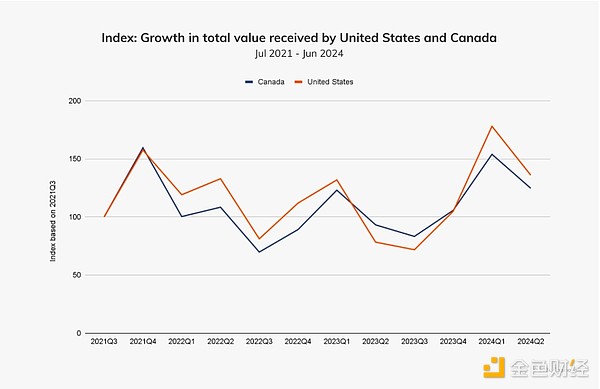
Canada is closely aligned with the global average in terms of asset distribution and transaction size. To understand the reality of the Canadian cryptocurrency landscape, we spoke to Kunal Bhasin, Partner and Co-Head of Advisory Services at KPMG’s Digital Assets Centre of Excellence. Bhasin provided insights into the state of cryptocurrency adoption in Canada, as well as some of the challenges facing the industry.
Several major Canadian crypto businesses have suspended operations in the country following last year’s regulatory changes that introduced stricter rules on custody, leverage, and stablecoins, with Gemini joining Binance and OKX as the latest exchanges to exit the market. However, Bhasin said the trend stems from more than just regulatory challenges. “Canadian regulators have provided more clarity to crypto exchanges than other North American jurisdictions by introducing the concept of crypto contracts, which clarifies the applicability of securities regulations to crypto platforms,” he explained. He believes the exchanges’ exits may stem from broader business decisions rather than an unworkable framework. Nonetheless, Bhasin stressed that Canadians still have “many regulated venues where they can participate in crypto in a meaningful way.”
While Canada’s regulatory framework for trading platforms and investment funds has helped maintain a level of confidence, gaps remain — particularly when it comes to the regulation of stablecoins and DeFi. “Canada’s regulatory approach to stablecoins is somewhat different than the approach taken by other forward-thinking jurisdictions such as the EU, UAE, Hong Kong and Singapore,” Bhasin explained. “There is no clear regulatory framework for stablecoins. As a result, you may see stablecoin issuers leaving Canada and related cryptocurrency innovation moving outside of Canada.”
Despite these hurdles, Bhasin spoke of promising developments. The Canadian Investment Regulatory Organization (CIRO) is a pan-Canadian self-regulatory organization that currently regulates all investment dealers, mutual fund dealers, and trading activities in Canada’s debt and equity markets. Under this framework, cryptocurrency exchanges must become members of CIRO, which subjects them to stricter disclosure, internal control and regulatory reporting requirements. “This is a sign of the maturing regulatory environment for cryptocurrency companies in Canada,” Bhasin said.
Another challenge to the adoption of cryptocurrencies in Canada is the reluctance of major financial institutions to meaningfully engage with cryptocurrencies. "Major banks around the world have taken appropriate steps to understand the unique risks of cryptocurrency companies under banking supervision and have incorporated enhanced due diligence programs related to cryptocurrency businesses, which are a new source of deposits for these banks. However, we have not seen Canadian banks take similar steps," Bhasin explained. "This has made it difficult for cryptocurrency companies to obtain banking services, resulting in some innovation moving outside of Canada." Additionally, he noted that large Canadian banks have cryptocurrency teams and have conducted various pilot programs and proofs of concept, but, "leadership tends to back off when it comes time to move beyond these pilots," he said, attributing this to risk aversion and a preference to maintain existing business models rather than disrupt them with new, potentially risky crypto ventures.
A significant driver of global cryptocurrency adoption has been the proactive stance of governments, such as Singapore and the UAE, which have made cryptocurrency part of their economic strategies. Bhasin said that greater government involvement could spur growth and investment. "More involvement is needed at the federal level to make digital assets a priority industry in Canada," he said.
Despite the challenges facing Canada’s cryptocurrency market, Bhasin is optimistic about the future, especially given the ongoing efforts of the public and private sectors. “Canada still has a strong regulatory environment for certain cryptocurrency activities such as investment funds,” said Bhasin, noting that Canada was the first country to launch a collateralized ETH ETF. “There is potential to develop this further by providing a clear roadmap for primary and secondary markets for tokenized real-world assets,” he added. “If the government makes crypto a priority and we continue to make progress in the regulatory space, there is no reason why Canada cannot take its place as a global leader in cryptocurrency adoption.”
The outsized influence of North America, and the United States in particular, on the global cryptocurrency market is undeniable. The region’s dominance during this period, driven by the introduction of ETPs and the evolving TradFi-crypto convergence, has significantly shaped the crypto landscape both domestically and internationally.As Gemini’s Claire Ching noted, “Institutional adoption has taken on a different flavor this cycle. It’s been more cautious and requires more diligence following the stunning fall of FTX in the last cycle. With this level of attention and resources, institutional commitment to the space is firmly cemented.”
Institutional giants like BlackRock are no longer just experimenting — they’ve invested fully, demonstrating that crypto has moved from the fringes to the mainstream financial conversation. Speaking about this paradigm shift, BlackRock’s Kevin Tang expressed the “importance of the continued view of blockchain as a transformative technology that has the potential to disrupt traditional paradigms and value chains — not just in finance, but more broadly across industries and sectors.”
Despite the momentum, challenges remain. Regulatory uncertainty in the U.S. and Canada, coupled with the shift in stablecoin market share outside of North America, underscores the need for a balanced mix of innovation, clear regulatory frameworks, and continued institutional support to ensure continued growth and stability across the crypto industry as a whole.
 JinseFinance
JinseFinanceActive AXS addresses were at a three-month high last week, and token prices surged more than 15 per cent.
 Alex
AlexToken prices for most Play-to-Earn (P2E) games crashed with the rest of the crypto market in 2022.
 Bitcoinist
BitcoinistSky Mavis co-founder and growth lead Jeffrey Zirlin says Axie Infinity wants to double down in South Korea, which they see as one of the most important gaming markets in the world.
 Cointelegraph
CointelegraphCan Axie Infinity rise to its former glory, as a form of “extreme entrepreneurship” where success can happen overnight, amid the crypto winter and uncertain global economy?
 Cointelegraph
CointelegraphThe bubble has well and truly burst for Axie Infinity (AXS) and Solana (SOL) in recent months. Axie Infinity (AXS) ...
 Bitcoinist
BitcoinistOnce the bridge reopens on June 28, users will be able to withdraw one ETH for each one they possessed before the attack.
 Cointelegraph
CointelegraphThe developers have managed to remove the fake news and remove the MEE6 bot from the main server.
 Cointelegraph
CointelegraphCrypto markets are crashing and it seems every other digital asset has been in the red for the longest time ...
 Bitcoinist
BitcoinistThe crypto mixer is said to have processed $20.5 million out of the $620 million taken by North Korean Lazarus Group hackers.
 Cointelegraph
Cointelegraph